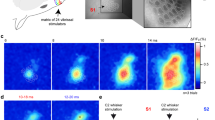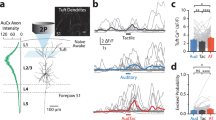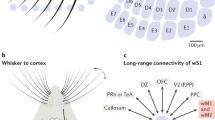Abstract
Cortical-feedback projections to primary sensory areas terminate most heavily in layer 1 (L1) of the neocortex 1,2, where they make synapses with tuft dendrites of pyramidal neurons. L1 input is thought to provide ‘contextual’ information3, but the signals transmitted by L1 feedback remain uncharacterized. In the rodent somatosensory system, the spatially diffuse4 feedback projection from vibrissal motor cortex (vM1) to vibrissal somatosensory cortex (vS1, also known as the barrel cortex) may allow whisker touch to be interpreted in the context of whisker position to compute object location5,6. When mice palpate objects with their whiskers to localize object features7,8, whisker touch excites vS19 and later vM1 in a somatotopic manner10,11,12,13. Here we use axonal calcium imaging to track activity in vM1→vS1 afferents in L1 of the barrel cortex while mice performed whisker-dependent object localization. Spatially intermingled individual axons represent whisker movements, touch and other behavioural features. In a subpopulation of axons, activity depends on object location and persists for seconds after touch. Neurons in the barrel cortex thus have information to integrate movements and touches of multiple whiskers over time, key components of object identification and navigation by active touch.
This is a preview of subscription content, access via your institution
Access options
Subscribe to this journal
Receive 51 print issues and online access
$199.00 per year
only $3.90 per issue
Buy this article
- Purchase on Springer Link
- Instant access to full article PDF
Prices may be subject to local taxes which are calculated during checkout




Similar content being viewed by others
References
Felleman, D. J. & Van Essen, D. C. Distributed hierarchical processing in the primate cerebral cortex. Cereb. Cortex 1, 1–47 (1991)
Cauller, L. J. & Connors, B. W. Synaptic physiology of horizontal afferents to layer 1 in slices of rat S1 neocortex. J. Neurosci. 14, 751–762 (1994)
Cauller, L. Layer I of primary sensory neocortex: where top-down converges upon bottom-up. Behav. Brain Res. 71, 163–170 (1995)
Veinante, P. & Deschenes, M. Single-cell study of motor cortex projections to the barrel field in rats. J. Comp. Neurol. 464, 98–103 (2003)
Petreanu, L., Mao, T., Sternson, S. M. & Svoboda, K. The subcellular organization of neocortical excitatory connections. Nature 457, 1142–1145 (2009)
Hill, D. N., Curtis, J. C., Moore, J. D. & Kleinfeld, D. Primary motor cortex reports efferent control of vibrissa motion on multiple timescales. Neuron 72, 344–356 (2011)
Knutsen, P. M., Pietr, M. & Ahissar, E. Haptic object localization in the vibrissal system: behavior and performance. J. Neurosci. 26, 8451–8464 (2006)
O’Connor, D. H. et al. Vibrissa-based object localization in head-fixed mice. J. Neurosci. 30, 1947–1967 (2010)
O’Connor, D. H., Peron, S. P., Huber, D. & Svoboda, K. Neural activity in barrel cortex underlying vibrissa-based object localization in mice. Neuron 67, 1048–1061 (2010)
Ferezou, I. et al. Spatiotemporal dynamics of cortical sensorimotor integration in behaving mice. Neuron 56, 907–923 (2007)
Kleinfeld, D., Sachdev, R. N., Merchant, L. M., Jarvis, M. R. & Ebner, F. F. Adaptive filtering of vibrissa input in motor cortex of rat. Neuron 34, 1021–1034 (2002)
Huber, D. et al. Multiple dynamic representations in the motor cortex during sensorimotor learning. Nature 484, 473–478 (2012)
Mao, T. et al. Long-range neuronal circuits underlying the interaction between sensory and motor cortex. Neuron 72, 111–123 (2011)
Clack, N. G. et al. Automated tracking of whiskers in videos of head fixed rodents. PLOS Comput. Biol. 8, e1002591 (2012)
Knutsen, P. M. & Ahissar, E. Orthogonal coding of object location. Trends Neurosci. 32, 101–109 (2009)
Birdwell, J. A. et al. Biomechanical models for radial distance determination by the rat vibrissal system. J. Neurophysiol. 98, 2439–2455 (2007)
Tian, L. et al. Imaging neural activity in worms, flies and mice with improved GCaMP calcium indicators. Nature Methods 6, 875–881 (2009)
Trachtenberg, J. T. et al. Long-term in vivo imaging of experience-dependent synaptic plasticity in adult cortex. Nature 420, 788–794 (2002)
Masino, S. A., Kwon, M. C., Dory, Y. & Frostig, R. D. Characterization of functional organization within rat barrel cortex using intrinsic signal optical imaging through a thinned skull. Proc. Natl Acad. Sci. USA 90, 9998–10002 (1993)
De Paola, V. et al. Cell type-specific structural plasticity of axonal branches and boutons in the adult neocortex. Neuron 49, 861–875 (2006)
Cox, C. L., Denk, W., Tank, D. W. & Svoboda, K. Action potentials reliably invade axonal arbors of rat neocortical neurons. Proc. Natl Acad. Sci. USA 97, 9724–9728 (2000)
Hooks, B. M. et al. Laminar analysis of excitatory local circuits in vibrissal motor and sensory cortical areas. PLoS Biol. 9, e1000572 (2011)
De Felipe, J., Marco, P., Fairen, A. & Jones, E. G. Inhibitory synaptogenesis in mouse somatosensory cortex. Cereb. Cortex 7, 619–634 (1997)
Carvell, G. E., Miller, S. A. & Simons, D. J. The relationship of vibrissal motor cortex unit activity to whisking in the awake rat. Somatosens. Mot. Res. 13, 115–127 (1996)
Komiyama, T. et al. Learning-related fine-scale specificity imaged in motor cortex circuits of behaving mice. Nature 464, 1182–1186 (2010)
Hernández, A. et al. Decoding a perceptual decision process across cortex. Neuron 66, 300–314 (2010)
Larkum, M. E., Senn, W. & Luscher, H. R. Top-down dendritic input increases the gain of layer 5 pyramidal neurons. Cereb. Cortex 14, 1059–1070 (2004)
Anjum, F., Turni, H., Mulder, P. G., van der Burg, J. & Brecht, M. Tactile guidance of prey capture in Etruscan shrews. Proc. Natl Acad. Sci. USA 103, 16544–16549 (2006)
Davidson, P. W. Haptic judgments of curvature by blind and sighted humans. J. Exp. Psychol. 93, 43–55 (1972)
Krupa, D. J., Matell, M. S., Brisben, A. J., Oliveira, L. M. & Nicolelis, M. A. Behavioral properties of the trigeminal somatosensory system in rats performing whisker-dependent tactile discriminations. J. Neurosci. 21, 5752–5763 (2001)
Kaneko, M., Hanover, J. L., England, P. M. & Stryker, M. P. TrkB kinase is required for recovery, but not loss, of cortical responses following monocular deprivation. Nature Neurosci. 11, 497–504 (2008)
Suter, B. A. et al. Ephus: multipurpose data acquisition software for neuroscience experiments. Front. Neural Circuits 4, 100 (2010)
Pologruto, T. A., Sabatini, B. L. & Svoboda, K. ScanImage: flexible software for operating laser-scanning microscopes. Biomed. Eng. Online 2, 13 (2003)
Guizar-Sicairos, M., Thurman, S. T. & Fienup, J. R. Efficient subpixel image registration algorithms. Opt. Lett. 33, 156–158 (2008)
Vogelstein, J. T. et al. Fast nonnegative deconvolution for spike train inference from population calcium imaging. J. Neurophysiol. 104, 3691–3704 (2010)
Hill, D. N., Bermejo, R., Zeigler, H. P. & Kleinfeld, D. Biomechanics of the vibrissa motor plant in rat: rhythmic whisking consists of triphasic neuromuscular activity. J. Neurosci. 28, 3438–3455 (2008)
Voigts, J., Sakmann, B. & Celikel, T. Unsupervised whisker tracking in unrestrained behaving animals. J. Neurophysiol. 100, 504–515 (2008)
Koester, H. J. & Sakmann, B. Calcium dynamics associated with action potentials in single nerve terminals of pyramidal cells in layer 2/3 of the young rat neocortex. J. Physiol. 529, 625–646 (2000)
Hastie, T., Tibshirani, R. & Friedman, J. The Elements of Statistical Learning 2nd edn (Springer, 2009)
Breiman, L. Random forests. Mach. Learn. 45, 5–32 (2001)
Duda, R. O., Hart, P. E. & Stork, D. G. Pattern Classification 2nd edn (Wiley, 2001)
Acknowledgements
We thank M. Hooks, N. Li, Z. Guo, J. Magee and J. Dudman for comments on the manuscript, N. Clack, V. Iyer and J. Vogelstein for help with software and D. Flickinger for help with microscope design.
Author information
Authors and Affiliations
Contributions
L.P. and K.S. conceived the study. L.P. performed the experiments. L.P., D.A.G. and K.S. analysed the data. D.A.G. and D.H.O. contributed software. D.H. and D.H.O. helped with behavioural and imaging experiments. N.-l.X. performed key pilot studies. L.T. and L.L. provided reagents. L.P., D.A.G. and K.S. wrote the paper with comments from all authors.
Corresponding author
Ethics declarations
Competing interests
The authors declare no competing financial interests.
Supplementary information
Supplementary Figures
This file contains Supplementary Figures 1-9. (PDF 1779 kb)
Rights and permissions
About this article
Cite this article
Petreanu, L., Gutnisky, D., Huber, D. et al. Activity in motor–sensory projections reveals distributed coding in somatosensation. Nature 489, 299–303 (2012). https://doi.org/10.1038/nature11321
Received:
Accepted:
Published:
Issue Date:
DOI: https://doi.org/10.1038/nature11321
This article is cited by
-
Motor cortex gates distractor stimulus encoding in sensory cortex
Nature Communications (2023)
-
An adaptive behavioral control motif mediated by cortical axo-axonic inhibition
Nature Neuroscience (2023)
-
Fast and sensitive GCaMP calcium indicators for imaging neural populations
Nature (2023)
-
Adaptive stimulus selection for consolidation in the hippocampus
Nature (2022)
-
Inhibitory regulation of calcium transients in prefrontal dendritic spines is compromised by a nonsense Shank3 mutation
Molecular Psychiatry (2021)
Comments
By submitting a comment you agree to abide by our Terms and Community Guidelines. If you find something abusive or that does not comply with our terms or guidelines please flag it as inappropriate.



